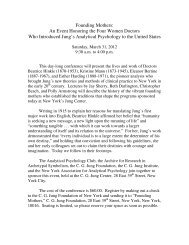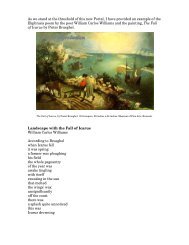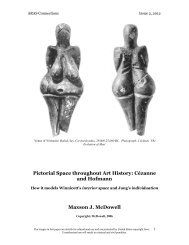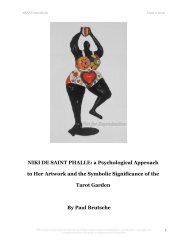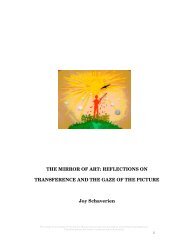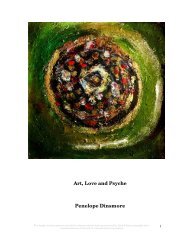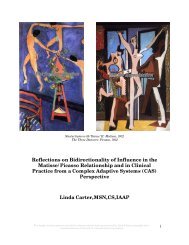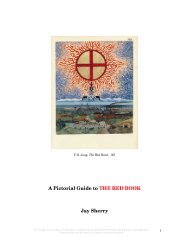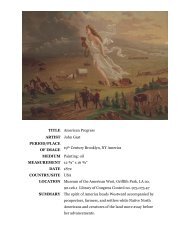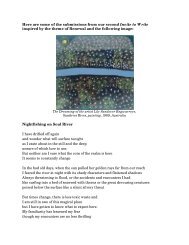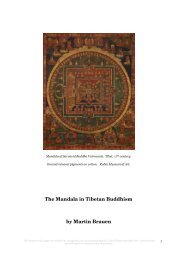The Book of Symbols - ARAS
The Book of Symbols - ARAS
The Book of Symbols - ARAS
Create successful ePaper yourself
Turn your PDF publications into a flip-book with our unique Google optimized e-Paper software.
<strong>The</strong> Making <strong>of</strong><br />
<strong>The</strong> <strong>Book</strong> <strong>of</strong> <strong>Symbols</strong><br />
by Ami Ronnberg<br />
On the morning <strong>of</strong> January, 2 nd 2008, at 10 am, the phone rang as we<br />
returned from the New Years holidays to the <strong>ARAS</strong> <strong>of</strong>fice on 39 th Street in New<br />
York City. It was Florian Kobler, an editor for Taschen <strong>Book</strong>s calling from<br />
Germany, eagerly asking if we had signed a contract already for our book on<br />
symbols (which we hadn’t). He told us that Benedikt Taschen, the owner <strong>of</strong> the<br />
world wide publishing company bearing his name had seen our proposal while<br />
visiting their Los Angeles <strong>of</strong>fice over the holidays and was interested in publishing<br />
the book. After months <strong>of</strong> negotiations a contract was signed. For the next three<br />
years we worked with Florian and his staff at Taschen who were all wonderfully<br />
supportive, attentive to every detail and set on the highest quality.<br />
<strong>The</strong> images in this paper are strictly for educational use and are protected by United States copyright laws.<br />
Unauthorized use will result in criminal and civil penalties.
This was eleven years after another surprise call, this time from Sam<br />
Bercholz, the Editor-in-Chief <strong>of</strong> Shambhala Publications who had previously<br />
published two volumes <strong>of</strong> the <strong>ARAS</strong> Encyclopedia <strong>of</strong> Archetypal Symbolism with<br />
two more volumes planned. He had always wanted to do a book on symbols and<br />
felt that the time was right as we were moving towards the year 2000. He wanted<br />
to name the book 1000 symbols for the New Millennium, to be published in time<br />
for the millennial shift. Initially, Thames & Hudson was to be co-publishing the<br />
book but for various reasons this was not to happen and a contract was never<br />
signed. By that time, board and staff had fallen in love with the project and we<br />
decided to continue with a great deal <strong>of</strong> faith and hope as well as much work.<br />
Perhaps a dream that one <strong>of</strong> the very first contributors told me early on may<br />
explain what gave us the courage. She dreamt that she was in a library and noticed<br />
a Jungian reference book. As she opened the book she found delicious fruits and<br />
nourishing beans falling <strong>of</strong>f the pages for her to eat. In the same way we may eat<br />
the seeds <strong>of</strong> symbols and they will feed us.<br />
During the years we were <strong>of</strong>ten asked why another book on symbols when<br />
there are so many and our answer was always the same: that there is no such book<br />
that includes images. Image is the language <strong>of</strong> the symbol. We are inundated by<br />
images as in no other time, and yet there seems to be a hunger for the deeper<br />
meaning, which is what makes them into symbols as they point to the mystery, to<br />
the unknown. Our editor Kathleen Martin, a Jungian analyst, brought her<br />
pr<strong>of</strong>ound knowledge <strong>of</strong> the psyche to this project by adding a psychological<br />
understanding <strong>of</strong> the symbol, which is also something unique for a book on<br />
symbols. We were lucky to have three working artists as well as a singer/musician,<br />
adding their sensibility to the whole. <strong>The</strong>y are Karen Arm, managing editor, Anne<br />
<strong>The</strong> images in this paper are strictly for educational use and are protected by United States copyright laws.<br />
Unauthorized use will result in criminal and civil penalties.
Thulin and Kako Ueda, assistant editors, and Allison Langerak, online editor. <strong>The</strong><br />
same wonderful team worked on this book for most <strong>of</strong> these years, which also<br />
explains the love that went into its preparation and hopefully can be felt in the<br />
result.<br />
Much care, many lively discussions and at times even strong disagreements<br />
went into selecting the images, which became the one task we all shared and<br />
adored. On Tuesday mornings we would meet in the <strong>ARAS</strong> reading room to go<br />
through the images that we had gathered during the week - from the <strong>ARAS</strong> files <strong>of</strong><br />
17,000 images and our extensive collection <strong>of</strong> art books. Wherever we went during<br />
this time we looked for images - in bookstores, museums, art galleries, our friends’<br />
book collections as well as our own. We wanted to cover contemporary art as well<br />
as all kinds <strong>of</strong> media and cultures. For example, the entry on “snow” includes a<br />
quiet 19 th century Japanese landscape by Hiroshige, snow flakes against a black<br />
door by Georgia O’Keeffe, a scientific photograph <strong>of</strong> a snow crystal and the ironic<br />
<strong>The</strong> Blizzard Ball Sale showing the artist David Hammons selling signed snow<br />
balls in New York City.<br />
However, our very first task was to select the thousand symbols, which we<br />
did by asking each board member and staff to write down their hundred favorite<br />
symbols and combine them with lists <strong>of</strong> entries from all the many symbol<br />
dictionaries in the archive. Not too far into the project we realized that this vision<br />
<strong>of</strong> a thousand symbols for the new millennium had to be adjusted to reality. Even<br />
reducing the number <strong>of</strong> entries to about a third has resulted in a book <strong>of</strong> 807 pages.<br />
It was painful to let go <strong>of</strong> many essential symbols and in the end we had selected<br />
enough images to fit two more books.<br />
<strong>The</strong> images in this paper are strictly for educational use and are protected by United States copyright laws.<br />
Unauthorized use will result in criminal and civil penalties.
In the history <strong>of</strong> the Archive and <strong>The</strong> <strong>Book</strong> <strong>of</strong> <strong>Symbols</strong> there is a long<br />
tradition <strong>of</strong> interest in images, which took root in a series <strong>of</strong> thematic conferences<br />
in Ascona, Switzerland named Eranos by its founder, Olga Froebe-Kapteyn. It was<br />
a delight to discover in her Preface to the printed lectures <strong>of</strong> the first conference a<br />
description that could also serve to introduce the writing in this book as well. She<br />
explains that the primary aim <strong>of</strong> the written texts was never a total treatment <strong>of</strong> the<br />
subject and writes “<strong>The</strong>ir value is evocative. <strong>The</strong>y touch upon unusual themes,<br />
facts, and analogies and in so doing evoke the great archetypal images.” Finding<br />
the right essay writers sometimes came from unexpected encounters and always<br />
meant much interaction while introducing them to this unusual writing where we<br />
asked them to evoke a symbol in a few hundred words, to include the facts as well<br />
as the wonder and to suggest a psychological understanding while combining text<br />
and image. Often we went back and forth, refining or rewriting some essential<br />
points. It turned out to be quite a challenge and required much hard work. For<br />
this we are deeply grateful to the contributors who include a range <strong>of</strong> pr<strong>of</strong>essions<br />
from academics, poets, to Jungian analysts.<br />
Anyone who has tried to obtain permission <strong>of</strong> images and poetry for<br />
publication knows how complex and time-consuming this is – and expensive. It is<br />
true detective work to track down the owners <strong>of</strong> the artwork, which may have<br />
changed hands more than once since the original source was published or was<br />
never known. Private collectors were equally challenging to locate. Imagine then<br />
finding the source for almost 800 images from countries across the globe - from a<br />
Japanese monastery, where our Japanese speaking colleague managed to work out<br />
an agreement with the monks using an intermediary from a Japanese image<br />
archive connected to the National Museum <strong>of</strong> Japan - to a museum in Mongolia<br />
<strong>The</strong> images in this paper are strictly for educational use and are protected by United States copyright laws.<br />
Unauthorized use will result in criminal and civil penalties.
where we happened to locate a British citizen who paved the way for our request by<br />
first visiting the museum and also suggesting we <strong>of</strong>fer a small financial<br />
contribution, which was customary in this culture before going on to ask for<br />
permissions. Only a tiny fraction <strong>of</strong> our requests were refused in the end.<br />
In preparing the many details, there was always a sense <strong>of</strong> gathering and<br />
organizing a symbolic world, where every aspect had its own importance. At the<br />
very end, another contributor told me a dream that he had about the book. This<br />
writer had helped us to read through the entire text for fact checking - from art<br />
historical details, scientific information, to the spelling <strong>of</strong> foreign names - and<br />
when he woke up he had the sense that the dream reflected the organic structure <strong>of</strong><br />
how this book had taken form. He dreamt that when he opened the book the first<br />
image had been replaced by the main image from the tree chapter, which is a<br />
painting by Georgia O’Keeffe. It shows the unusual perspective <strong>of</strong> looking up into<br />
the crown <strong>of</strong> the tree, its branches reaching into the starry sky. In the dream it<br />
seemed that each individual entry was like the branch <strong>of</strong> a tree that somehow grew<br />
from its heart, the core <strong>of</strong> the trunk <strong>of</strong> that Tree. This is the Tree <strong>of</strong> Life containing<br />
all the symbols and we hope it will continue to grow as this book is now published.<br />
<strong>The</strong> images in this paper are strictly for educational use and are protected by United States copyright laws.<br />
Unauthorized use will result in criminal and civil penalties.
CAPTIONS FOR THE IMAGES IN THIS ARTICLE:<br />
Jyoti (Light). Spirit and matter—the transparency <strong>of</strong><br />
consciousness and the crystallization <strong>of</strong> light as form—<br />
coalesce in the golden disk <strong>of</strong> the sun. Tempura painting with<br />
gold, ca. 18 th century, India.<br />
In a cosmic feat <strong>of</strong> levitation, the goddess “She who annihilates”<br />
raises the orange-black globe <strong>of</strong> the sun above the worshipping<br />
horizons <strong>of</strong> the east and the west. Detail from a wall painting in<br />
the tomb <strong>of</strong> Ramses VI, ca. 1145-37 B.C.E., Valley <strong>of</strong> the Kings,<br />
Egypt.<br />
<strong>The</strong> formidable and invigorating power <strong>of</strong> the feminine as<br />
mediator and image <strong>of</strong> the self is embodied by the figure <strong>of</strong><br />
Luna standing in the curve <strong>of</strong> the crescent moon. From the<br />
wedding book Le nozze di Constantio Sforza e Camilla<br />
d’Aragona, 1480, Italy.<br />
<strong>The</strong> Lawrence Tree by Georgia O’Keeffe seen in a dream by<br />
one <strong>of</strong> the contributors as the organic structure <strong>of</strong> <strong>The</strong> <strong>Book</strong><br />
<strong>of</strong> <strong>Symbols</strong>.. Oil on canvas, 1919, United States.<br />
<strong>The</strong> images in this paper are strictly for educational use and are protected by United States copyright laws.<br />
Unauthorized use will result in criminal and civil penalties.
<strong>The</strong> goddess Isis as a tree suckling the pharaoh, as if <strong>of</strong>fering him<br />
fruits <strong>of</strong> a tree. Painting from the tomb <strong>of</strong> Pharaoh Thutmose III<br />
(ca. 1479-21 B.C.E.)<br />
Alchemy’s tree also resembles the dream where the structure <strong>of</strong><br />
<strong>The</strong> <strong>Book</strong> <strong>of</strong> <strong>Symbols</strong> is seen as a tree that is organic, yet man-<br />
made. <strong>The</strong> sun, moon and stars as luminous gold and silver<br />
fruits are hanging from its branches. Engraving, ca. 1470.<br />
<strong>The</strong> images in this paper are strictly for educational use and are protected by United States copyright laws.<br />
Unauthorized use will result in criminal and civil penalties.



